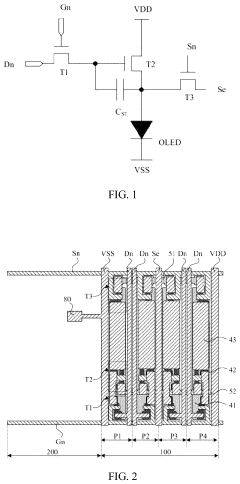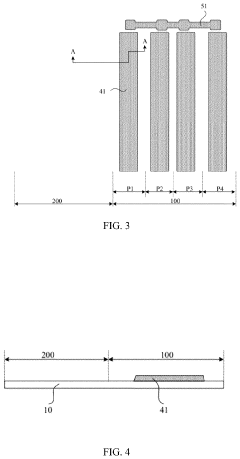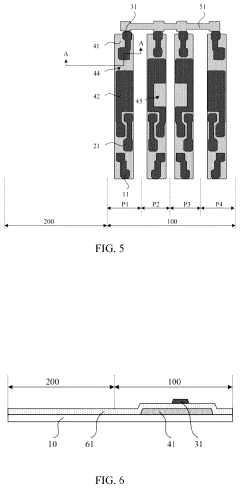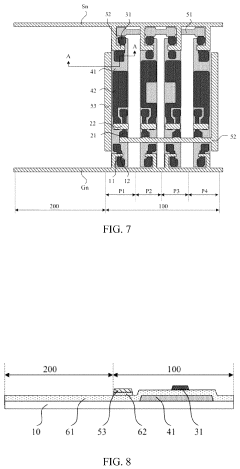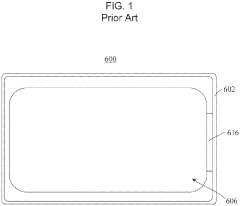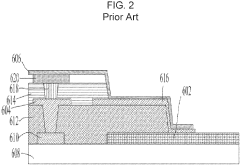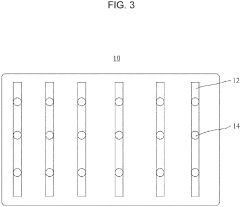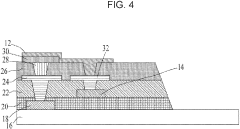Implications of variable AMOLED transparency in privacy enhancements.
JUL 17, 20259 MIN READ
Generate Your Research Report Instantly with AI Agent
Patsnap Eureka helps you evaluate technical feasibility & market potential.
AMOLED Transparency Evolution and Objectives
AMOLED (Active-Matrix Organic Light-Emitting Diode) technology has undergone significant evolution since its inception, particularly in the realm of transparency. The journey towards variable transparency in AMOLED displays represents a convergence of display technology and privacy enhancement efforts, addressing growing concerns about visual privacy in an increasingly digital world.
The primary objective of developing variable AMOLED transparency is to create displays that can dynamically adjust their opacity, offering users control over the visibility of their screen content to others. This technology aims to balance the need for clear, vibrant displays with the demand for privacy in various environments, from public spaces to secure workplaces.
Historically, AMOLED displays have been praised for their high contrast ratios, wide color gamut, and energy efficiency. The pursuit of transparency adds another dimension to these capabilities, opening up new possibilities for device design and user interaction. Early experiments with transparent OLED technology date back to the early 2000s, but it is only in recent years that variable transparency has become a viable feature for consumer electronics.
The evolution of AMOLED transparency has been driven by several key factors. Advancements in organic materials and pixel structures have improved light transmission through the display. Innovations in thin-film transistor (TFT) technology have enabled the creation of nearly invisible circuitry, crucial for achieving high levels of transparency. Additionally, the development of sophisticated control systems allows for real-time adjustment of transparency levels.
Current objectives in AMOLED transparency research focus on several areas. Enhancing the range of transparency, from fully opaque to nearly invisible, is a primary goal. Researchers are also working to improve the speed of transition between transparency states, aiming for seamless and instantaneous adjustments. Another critical objective is to maintain display quality and color accuracy across all transparency levels, ensuring that image integrity is not compromised.
In the context of privacy enhancements, variable AMOLED transparency presents unique opportunities. The ability to instantly obscure screen content from prying eyes without the need for physical screen protectors or filters is a significant advancement. This feature is particularly valuable in scenarios where sensitive information is being viewed in public spaces or shared work environments.
Looking forward, the integration of variable transparency with other emerging technologies, such as augmented reality (AR) and smart windows, represents an exciting frontier. The potential for creating displays that can seamlessly transition between being information portals and transparent surfaces opens up new possibilities for user interfaces and environmental integration.
As research progresses, balancing power consumption with transparency control remains a key challenge. The ultimate goal is to achieve variable transparency without significantly impacting battery life or overall device performance, ensuring that privacy features do not come at the cost of user experience or device longevity.
The primary objective of developing variable AMOLED transparency is to create displays that can dynamically adjust their opacity, offering users control over the visibility of their screen content to others. This technology aims to balance the need for clear, vibrant displays with the demand for privacy in various environments, from public spaces to secure workplaces.
Historically, AMOLED displays have been praised for their high contrast ratios, wide color gamut, and energy efficiency. The pursuit of transparency adds another dimension to these capabilities, opening up new possibilities for device design and user interaction. Early experiments with transparent OLED technology date back to the early 2000s, but it is only in recent years that variable transparency has become a viable feature for consumer electronics.
The evolution of AMOLED transparency has been driven by several key factors. Advancements in organic materials and pixel structures have improved light transmission through the display. Innovations in thin-film transistor (TFT) technology have enabled the creation of nearly invisible circuitry, crucial for achieving high levels of transparency. Additionally, the development of sophisticated control systems allows for real-time adjustment of transparency levels.
Current objectives in AMOLED transparency research focus on several areas. Enhancing the range of transparency, from fully opaque to nearly invisible, is a primary goal. Researchers are also working to improve the speed of transition between transparency states, aiming for seamless and instantaneous adjustments. Another critical objective is to maintain display quality and color accuracy across all transparency levels, ensuring that image integrity is not compromised.
In the context of privacy enhancements, variable AMOLED transparency presents unique opportunities. The ability to instantly obscure screen content from prying eyes without the need for physical screen protectors or filters is a significant advancement. This feature is particularly valuable in scenarios where sensitive information is being viewed in public spaces or shared work environments.
Looking forward, the integration of variable transparency with other emerging technologies, such as augmented reality (AR) and smart windows, represents an exciting frontier. The potential for creating displays that can seamlessly transition between being information portals and transparent surfaces opens up new possibilities for user interfaces and environmental integration.
As research progresses, balancing power consumption with transparency control remains a key challenge. The ultimate goal is to achieve variable transparency without significantly impacting battery life or overall device performance, ensuring that privacy features do not come at the cost of user experience or device longevity.
Privacy-Enhanced Display Market Analysis
The privacy-enhanced display market has witnessed significant growth in recent years, driven by increasing concerns over data privacy and security across various sectors. This market segment encompasses a range of technologies designed to protect sensitive information displayed on screens from unauthorized viewing, with variable AMOLED transparency emerging as a promising solution.
The demand for privacy-enhanced displays is particularly strong in industries handling confidential data, such as finance, healthcare, and government sectors. These sectors require robust solutions to prevent visual hacking and protect sensitive information from prying eyes. The corporate sector also shows a growing interest in privacy-enhanced displays, especially for use in open office environments and during business travel.
Market research indicates that the global privacy-enhanced display market is experiencing steady growth. The increasing adoption of mobile devices and the rise of remote work have further accelerated this trend, as users seek ways to protect their on-screen information in public spaces. Additionally, the growing awareness of data protection regulations, such as GDPR in Europe and CCPA in California, has prompted organizations to invest in privacy-enhancing technologies, including displays.
Variable AMOLED transparency technology offers a unique value proposition in this market. By allowing users to adjust the transparency of their screens, it provides a dynamic solution that can adapt to different environments and privacy needs. This flexibility is particularly appealing to users who require both privacy and visibility in varying contexts.
The market for privacy-enhanced displays with variable transparency is still in its early stages but shows promising growth potential. Early adopters are likely to be high-end smartphone manufacturers and premium laptop producers, targeting security-conscious professionals and privacy-aware consumers. As the technology matures and production costs decrease, it is expected to penetrate broader market segments.
Geographically, North America and Europe lead in the adoption of privacy-enhanced display technologies, driven by stringent data protection regulations and a high concentration of industries dealing with sensitive information. Asia-Pacific is emerging as a rapidly growing market, fueled by increasing smartphone penetration and rising privacy concerns in countries like China and South Korea.
The competitive landscape of the privacy-enhanced display market is characterized by a mix of established electronics manufacturers and innovative startups. Major players are investing in research and development to improve existing technologies and develop new solutions like variable AMOLED transparency. Partnerships between display manufacturers and privacy technology companies are becoming more common, aiming to create integrated solutions that offer both high-quality visuals and robust privacy features.
The demand for privacy-enhanced displays is particularly strong in industries handling confidential data, such as finance, healthcare, and government sectors. These sectors require robust solutions to prevent visual hacking and protect sensitive information from prying eyes. The corporate sector also shows a growing interest in privacy-enhanced displays, especially for use in open office environments and during business travel.
Market research indicates that the global privacy-enhanced display market is experiencing steady growth. The increasing adoption of mobile devices and the rise of remote work have further accelerated this trend, as users seek ways to protect their on-screen information in public spaces. Additionally, the growing awareness of data protection regulations, such as GDPR in Europe and CCPA in California, has prompted organizations to invest in privacy-enhancing technologies, including displays.
Variable AMOLED transparency technology offers a unique value proposition in this market. By allowing users to adjust the transparency of their screens, it provides a dynamic solution that can adapt to different environments and privacy needs. This flexibility is particularly appealing to users who require both privacy and visibility in varying contexts.
The market for privacy-enhanced displays with variable transparency is still in its early stages but shows promising growth potential. Early adopters are likely to be high-end smartphone manufacturers and premium laptop producers, targeting security-conscious professionals and privacy-aware consumers. As the technology matures and production costs decrease, it is expected to penetrate broader market segments.
Geographically, North America and Europe lead in the adoption of privacy-enhanced display technologies, driven by stringent data protection regulations and a high concentration of industries dealing with sensitive information. Asia-Pacific is emerging as a rapidly growing market, fueled by increasing smartphone penetration and rising privacy concerns in countries like China and South Korea.
The competitive landscape of the privacy-enhanced display market is characterized by a mix of established electronics manufacturers and innovative startups. Major players are investing in research and development to improve existing technologies and develop new solutions like variable AMOLED transparency. Partnerships between display manufacturers and privacy technology companies are becoming more common, aiming to create integrated solutions that offer both high-quality visuals and robust privacy features.
AMOLED Transparency Variability Challenges
The variability in AMOLED transparency presents significant challenges for privacy enhancement applications. One of the primary issues is the inconsistency in transparency levels across different AMOLED panels, even within the same production batch. This variability can lead to unpredictable privacy performance, as the intended level of opacity may not be uniformly achieved across all devices.
Another challenge lies in the dynamic nature of AMOLED displays. The transparency of these panels can change over time due to factors such as temperature, usage patterns, and aging of organic materials. This temporal instability complicates the implementation of consistent privacy features, as the effectiveness of transparency-based privacy measures may degrade or fluctuate over the lifespan of the device.
The power consumption associated with variable transparency is also a significant concern. Adjusting the transparency of AMOLED panels typically requires additional energy, which can impact the overall battery life of mobile devices. Balancing the need for privacy enhancement with power efficiency becomes a critical challenge, especially for devices with limited battery capacity.
Furthermore, the integration of variable transparency features with existing display technologies poses technical hurdles. Ensuring seamless operation between standard display modes and privacy-enhanced modes requires sophisticated control systems and software algorithms. These systems must be capable of rapid and precise adjustments to transparency levels without compromising display quality or user experience.
The manufacturing process itself introduces challenges in achieving consistent transparency variability. Precise control over the deposition of organic materials and the formation of transparent electrodes is crucial for uniform transparency control. However, current manufacturing techniques may not always provide the level of precision required for privacy-critical applications.
Lastly, the interaction between variable transparency and other display characteristics, such as color accuracy, contrast ratio, and viewing angles, presents complex engineering challenges. Maintaining optimal visual performance while implementing privacy features through transparency modulation requires careful calibration and may involve trade-offs in display quality.
Addressing these challenges will require advancements in materials science, manufacturing processes, and display control technologies. Innovations in organic materials with more stable and predictable transparency properties, improved manufacturing techniques for greater uniformity, and sophisticated algorithms for real-time transparency adjustment will be crucial in overcoming the current limitations of variable AMOLED transparency for privacy enhancement applications.
Another challenge lies in the dynamic nature of AMOLED displays. The transparency of these panels can change over time due to factors such as temperature, usage patterns, and aging of organic materials. This temporal instability complicates the implementation of consistent privacy features, as the effectiveness of transparency-based privacy measures may degrade or fluctuate over the lifespan of the device.
The power consumption associated with variable transparency is also a significant concern. Adjusting the transparency of AMOLED panels typically requires additional energy, which can impact the overall battery life of mobile devices. Balancing the need for privacy enhancement with power efficiency becomes a critical challenge, especially for devices with limited battery capacity.
Furthermore, the integration of variable transparency features with existing display technologies poses technical hurdles. Ensuring seamless operation between standard display modes and privacy-enhanced modes requires sophisticated control systems and software algorithms. These systems must be capable of rapid and precise adjustments to transparency levels without compromising display quality or user experience.
The manufacturing process itself introduces challenges in achieving consistent transparency variability. Precise control over the deposition of organic materials and the formation of transparent electrodes is crucial for uniform transparency control. However, current manufacturing techniques may not always provide the level of precision required for privacy-critical applications.
Lastly, the interaction between variable transparency and other display characteristics, such as color accuracy, contrast ratio, and viewing angles, presents complex engineering challenges. Maintaining optimal visual performance while implementing privacy features through transparency modulation requires careful calibration and may involve trade-offs in display quality.
Addressing these challenges will require advancements in materials science, manufacturing processes, and display control technologies. Innovations in organic materials with more stable and predictable transparency properties, improved manufacturing techniques for greater uniformity, and sophisticated algorithms for real-time transparency adjustment will be crucial in overcoming the current limitations of variable AMOLED transparency for privacy enhancement applications.
Current Variable Transparency Solutions
01 Transparent AMOLED display structures
Transparent AMOLED displays are designed with specific structures to allow light transmission through the display. This involves using transparent electrodes, light-emitting layers, and substrate materials. The design may include strategically placed transparent areas or pixel arrangements to achieve a balance between display functionality and transparency.- Transparent AMOLED display structures: AMOLED displays can be designed with transparent structures, allowing light to pass through the display. This is achieved by using transparent electrodes, such as indium tin oxide (ITO), and optimizing the arrangement of organic layers and thin-film transistors to maximize light transmission. These transparent displays can be used in various applications, including augmented reality devices and heads-up displays.
- Pixel circuit designs for transparent AMOLEDs: Specialized pixel circuit designs are developed to enable transparency in AMOLED displays. These circuits often incorporate transparent thin-film transistors and capacitors, arranged in a way that minimizes obstruction of light. The designs may also include compensation mechanisms to ensure uniform brightness and color across the transparent display area.
- Integration of transparent AMOLEDs with other components: Transparent AMOLED displays can be integrated with other components to create multifunctional devices. This includes combining transparent displays with camera modules, sensors, or other display layers. Such integration enables the development of see-through smartphones, smart windows, or advanced automotive displays with enhanced functionality.
- Driving methods for transparent AMOLED displays: Specific driving methods are developed to address the unique challenges of transparent AMOLED displays. These methods may include techniques for compensating for variations in light transmission, managing power consumption, and optimizing image quality in different ambient light conditions. Advanced driving schemes can help maintain display performance while maximizing transparency.
- Fabrication techniques for transparent AMOLEDs: Specialized fabrication techniques are employed to create transparent AMOLED displays. These may include methods for depositing transparent conductive materials, patterning transparent electrodes, and encapsulating the display to protect it from environmental factors while maintaining transparency. Advanced manufacturing processes aim to improve yield and reduce costs for transparent AMOLED production.
02 Pixel circuit designs for transparent AMOLEDs
Specialized pixel circuits are developed for transparent AMOLED displays to maintain display performance while allowing light transmission. These circuits may include transparent thin-film transistors (TFTs) and capacitors, as well as optimized layouts to minimize opaque components. The designs aim to balance transparency with display quality and power efficiency.Expand Specific Solutions03 Transparent electrode materials and fabrication
Transparent conductive materials are crucial for AMOLED display transparency. Research focuses on developing and optimizing materials such as indium tin oxide (ITO), graphene, or metal nanowires for use as transparent electrodes. Fabrication techniques are developed to ensure uniform deposition and patterning of these materials while maintaining their transparency and conductivity.Expand Specific Solutions04 Optical compensation and enhancement techniques
Various optical techniques are employed to improve the transparency and visual quality of AMOLED displays. These may include anti-reflection coatings, polarizers, and optical films to reduce glare and enhance light transmission. Additionally, color filter arrangements and light management structures are optimized to balance transparency with color reproduction and contrast.Expand Specific Solutions05 Integration of transparent AMOLEDs in devices
Transparent AMOLED displays are integrated into various devices and applications, such as smartphones, wearables, and automotive displays. This integration involves addressing challenges related to power management, touch functionality, and durability. Innovative device designs may incorporate transparent displays as overlays or in dual-sided configurations to enable new user experiences and form factors.Expand Specific Solutions
Key AMOLED Manufacturers and Innovators
The variable AMOLED transparency technology for privacy enhancements is in an early development stage, with a growing but still limited market. The technology's maturity is progressing, with key players like Samsung Display, LG Display, and BOE Technology leading research efforts. These companies are leveraging their expertise in OLED displays to advance transparency control features. While not yet widely commercialized, major smartphone and consumer electronics manufacturers like Samsung Electronics, LG Electronics, and Xiaomi are exploring potential applications, indicating increasing industry interest in this privacy-focused display innovation.
BOE Technology Group Co., Ltd.
Technical Solution: BOE has developed a variable transparency AMOLED technology called "Smart Window Display". This solution incorporates a liquid crystal layer between the AMOLED panel and a transparent substrate, allowing electrical control of opacity[7]. BOE's technology can achieve transparency levels from 0% to over 90% with minimal impact on display quality. They have also implemented localized transparency control, enabling partial screen privacy[8]. BOE has demonstrated integration of this technology with in-display fingerprint sensors and under-panel cameras for a seamless user experience[9].
Strengths: Large-scale production capabilities, strong presence in the Chinese market. Weaknesses: Less established brand recognition in Western markets, potential intellectual property challenges.
LG Display Co., Ltd.
Technical Solution: LG Display has introduced a variable transparency OLED technology for privacy applications. Their approach uses a switchable privacy filter layer composed of liquid crystals and polarizers integrated with OLED panels[4]. This allows the display to transition between a wide viewing angle mode and a narrow viewing angle privacy mode. LG has also developed a multi-layer OLED stack that can independently control transparency of different color channels, enabling selective privacy for specific on-screen content[5]. The company has demonstrated prototypes with response times under 1ms for rapid switching between modes[6].
Strengths: Expertise in large-format OLED displays, established relationships with device manufacturers. Weaknesses: Less experience with small form-factor mobile displays compared to some competitors.
Core Patents in AMOLED Transparency Control
Display substrate and preparation method thereof, and display apparatus
PatentActiveUS11895879B2
Innovation
- Incorporating an auxiliary cathode in the transparent area, connected with the second power supply line, which changes the transparent area into an irregular shape, reducing diffraction by generating diffraction fringes at different positions and directions, and providing a low-level signal to the cathode of the light emitting element.
Active-matrix organic light-emitting diode (AMOLED) display module
PatentActiveUS11257882B2
Innovation
- A second conductive layer is uniformly arranged across the AMOLED display panel to ensure consistent common ground voltage distribution to the cathode, maintaining a uniform voltage difference across each OLED element, thereby enhancing luminance uniformity.
Cybersecurity Implications of Variable Transparency
Variable transparency in AMOLED displays presents significant cybersecurity implications that warrant careful consideration. As these displays become more prevalent in consumer devices, the ability to dynamically adjust screen transparency introduces new vectors for potential privacy breaches and security vulnerabilities.
One of the primary concerns is the risk of visual eavesdropping. When a display is set to a higher level of transparency, it becomes easier for unauthorized individuals to view sensitive information from various angles. This is particularly problematic in public spaces or shared work environments where confidential data may be exposed inadvertently. The dynamic nature of variable transparency further complicates this issue, as users may not always be aware of their current transparency settings.
Another critical aspect is the potential for malicious exploitation of transparency features. Sophisticated attackers could potentially manipulate transparency levels remotely, creating opportunities for social engineering attacks or covert information gathering. For instance, a compromised device could be instructed to increase transparency at specific moments, allowing an attacker to capture sensitive data without the user's knowledge.
The integration of variable transparency technology with other device features also raises concerns. For example, the interplay between transparency settings and biometric authentication systems could lead to unforeseen security vulnerabilities. An attacker might exploit varying transparency levels to bypass facial recognition or other visual security measures.
From a data protection standpoint, the management of transparency settings introduces new challenges in maintaining user privacy. The preferences and patterns of transparency usage could potentially be tracked and analyzed, providing valuable insights into user behavior and potentially compromising personal information.
Furthermore, the implementation of variable transparency features may introduce additional complexity to the device's software and hardware architecture. This increased complexity could potentially expand the attack surface, providing more entry points for malicious actors to exploit.
To address these cybersecurity implications, it is crucial to develop robust security protocols and user education programs specifically tailored to variable transparency technologies. This may include implementing intelligent transparency management systems that automatically adjust based on environmental factors and user context, as well as enhancing encryption methods for on-screen data to mitigate risks associated with visual exposure.
One of the primary concerns is the risk of visual eavesdropping. When a display is set to a higher level of transparency, it becomes easier for unauthorized individuals to view sensitive information from various angles. This is particularly problematic in public spaces or shared work environments where confidential data may be exposed inadvertently. The dynamic nature of variable transparency further complicates this issue, as users may not always be aware of their current transparency settings.
Another critical aspect is the potential for malicious exploitation of transparency features. Sophisticated attackers could potentially manipulate transparency levels remotely, creating opportunities for social engineering attacks or covert information gathering. For instance, a compromised device could be instructed to increase transparency at specific moments, allowing an attacker to capture sensitive data without the user's knowledge.
The integration of variable transparency technology with other device features also raises concerns. For example, the interplay between transparency settings and biometric authentication systems could lead to unforeseen security vulnerabilities. An attacker might exploit varying transparency levels to bypass facial recognition or other visual security measures.
From a data protection standpoint, the management of transparency settings introduces new challenges in maintaining user privacy. The preferences and patterns of transparency usage could potentially be tracked and analyzed, providing valuable insights into user behavior and potentially compromising personal information.
Furthermore, the implementation of variable transparency features may introduce additional complexity to the device's software and hardware architecture. This increased complexity could potentially expand the attack surface, providing more entry points for malicious actors to exploit.
To address these cybersecurity implications, it is crucial to develop robust security protocols and user education programs specifically tailored to variable transparency technologies. This may include implementing intelligent transparency management systems that automatically adjust based on environmental factors and user context, as well as enhancing encryption methods for on-screen data to mitigate risks associated with visual exposure.
User Experience and Ergonomic Considerations
The integration of variable AMOLED transparency technology in privacy enhancement applications presents unique challenges and opportunities in terms of user experience and ergonomic considerations. As this technology allows for dynamic adjustment of screen transparency, it significantly impacts how users interact with their devices and perceive information.
One of the primary considerations is the visual comfort and eye strain associated with varying levels of transparency. Users may experience difficulty in focusing or reading content when the screen alternates between different transparency states. This necessitates careful calibration of transparency levels and transition speeds to ensure a smooth and comfortable viewing experience. Additionally, the impact of ambient lighting conditions on the visibility of content through transparent screens must be thoroughly evaluated to maintain readability across diverse environments.
Ergonomic factors also play a crucial role in the implementation of variable transparency. The physical positioning and handling of devices with transparent displays may need to be reconsidered, as users might inadvertently obstruct the view or create unintended shadows. This could lead to the development of new form factors or grip designs that optimize the user's interaction with transparent screens while maintaining privacy.
The cognitive load on users is another significant aspect to consider. The dynamic nature of variable transparency may require users to adapt to changing visual cues and information presentation methods. This adaptation process could potentially impact task efficiency and user satisfaction, especially during initial adoption phases. Designers must strike a balance between leveraging the privacy benefits of transparency and maintaining a consistent, intuitive user interface.
Furthermore, the integration of variable transparency features with existing user interface paradigms presents both challenges and opportunities. Developers need to consider how transparency changes affect touch input accuracy, gesture recognition, and overall navigation within applications. This may lead to the creation of new interaction models specifically tailored for transparent displays, potentially revolutionizing how users engage with their devices.
Accessibility considerations are paramount when implementing variable transparency technologies. Users with visual impairments or cognitive disabilities may face unique challenges in adapting to dynamic screen changes. Customizable settings and alternative interaction modes should be developed to ensure inclusivity and equal access to privacy-enhancing features for all users.
One of the primary considerations is the visual comfort and eye strain associated with varying levels of transparency. Users may experience difficulty in focusing or reading content when the screen alternates between different transparency states. This necessitates careful calibration of transparency levels and transition speeds to ensure a smooth and comfortable viewing experience. Additionally, the impact of ambient lighting conditions on the visibility of content through transparent screens must be thoroughly evaluated to maintain readability across diverse environments.
Ergonomic factors also play a crucial role in the implementation of variable transparency. The physical positioning and handling of devices with transparent displays may need to be reconsidered, as users might inadvertently obstruct the view or create unintended shadows. This could lead to the development of new form factors or grip designs that optimize the user's interaction with transparent screens while maintaining privacy.
The cognitive load on users is another significant aspect to consider. The dynamic nature of variable transparency may require users to adapt to changing visual cues and information presentation methods. This adaptation process could potentially impact task efficiency and user satisfaction, especially during initial adoption phases. Designers must strike a balance between leveraging the privacy benefits of transparency and maintaining a consistent, intuitive user interface.
Furthermore, the integration of variable transparency features with existing user interface paradigms presents both challenges and opportunities. Developers need to consider how transparency changes affect touch input accuracy, gesture recognition, and overall navigation within applications. This may lead to the creation of new interaction models specifically tailored for transparent displays, potentially revolutionizing how users engage with their devices.
Accessibility considerations are paramount when implementing variable transparency technologies. Users with visual impairments or cognitive disabilities may face unique challenges in adapting to dynamic screen changes. Customizable settings and alternative interaction modes should be developed to ensure inclusivity and equal access to privacy-enhancing features for all users.
Unlock deeper insights with Patsnap Eureka Quick Research — get a full tech report to explore trends and direct your research. Try now!
Generate Your Research Report Instantly with AI Agent
Supercharge your innovation with Patsnap Eureka AI Agent Platform!
